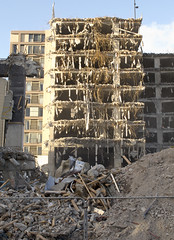
Search
Images for demolished; more images...
Christchurch Press Image: Iain McGregor 2010:09:05 05:03:01
Images, UC QuakeStudies
Photograph captioned by Fairfax, "Major earthquake hits Christchurch. St Albans Sea Foods shop all but demolished".
Photograph by Jocelyn Kinghorn 602
Images, UC QuakeStudies
The word "red" has been spray painted across a brick wall that has been mostly demolished.
Photograph by Eroica Ritchie 181
Images, UC QuakeStudies
Weeds growing on the site of a demolished building. In the foreground is an abandoned shoe.
Photograph by Eroica Ritchie 184
Images, UC QuakeStudies
The arm of a long reach excavator rising above the broken columns of a demolished building.
Photograph by Jocelyn Kinghorn 1795
Images, UC QuakeStudies
The Triton Dairy has reopened in a container on the site of its demolished former building.
Photograph by Jocelyn Kinghorn 2605
Images, UC QuakeStudies
Detail of fence around the site of the demolished St. John's Anglican Church on Latimer Square.
Photograph of 468 Colombo Street (1)
Images, UC QuakeStudies
A photograph of a digger clearing the remains of a demolished building at 468 Colombo Street.
Photograph of 468 Colombo Street (2)
Images, UC QuakeStudies
A photograph of a digger clearing the remains of a demolished building at 468 Colombo Street.
Photograph of 468 Colombo Street (3)
Images, UC QuakeStudies
A photograph of a digger clearing the remains of a demolished building at 468 Colombo Street.
Christchurch Press Image: Iain McGregor 2010:09:05 05:07:35
Images, UC QuakeStudies
Photograph captioned by Fairfax, "Major earthquake hits Christchurch. St Albans Sea Foods shop all but demolished".
Photograph of the Cranmer Centre, 40 Armagh Street (448)
Images, UC QuakeStudies
A photograph of an excavator clearing rubble from the site of the partially-demolished Cranmer Centre.
Photograph of the Cranmer Centre, 40 Armagh Street (450)
Images, UC QuakeStudies
A photograph of an excavator clearing rubble from the site of the partially-demolished Cranmer Centre.
SuperValue Coming Down 07
Images, eqnz.chch.2010
Edgeware Supervalue Supermarket being demolished after the 6.3 magnitude quake hit Christchurch 22 February 2011.
Colombo Street, Sydenham
Images, eqnz.chch.2010
The Greek Souvlaki place was closed for several months while the building next door got demolished.
The impacts of the Canterbury earthquake on the commercial office market
Research Papers, Lincoln University
Lincoln University and CBRE, a commercial real estate service provider, have conducted research to investigate the impacts of the Canterbury earthquake on the commercial office market in Christchurch. The 22 February 2011 Canterbury earthquake had a devastating impact on Christchurch property with significant damage caused to land and buildings. As at January 2012, around 740 buildings have either been demolished or identified to be demolished in central Christchurch. On top of this, around 140 buildings have either been partially demolished or identified to be partially demolished. The broad aims of our research are to (i) examine the nature and extent of the CBD office relocation, (ii) identify the nature of the occupiers, (iii) determine occupier’s perceptions of the future: their location and space needs post the February earthquake, and the likelihood of relocating back to the CBD after the rebuild, and (iv) find out what occupiers see as the future of the CBD, and how they want this to look.
Photograph of the Cranmer Centre, 40 Armagh Street (112)
Images, UC QuakeStudies
A photograph of the partially-demolished Cranmer Centre. Some of the wooden beams have writing on them.
Photograph of the Cranmer Centre, 40 Armagh Street (113)
Images, UC QuakeStudies
A photograph of the partially-demolished Cranmer Centre. Some of the wooden beams have writing on them.
Photograph of the Cranmer Centre, 40 Armagh Street (110)
Images, UC QuakeStudies
A photograph of the partially-demolished Cranmer Centre. One of the wooden beams has writing on it.
Photograph of the Cranmer Centre, 40 Armagh Street (111)
Images, UC QuakeStudies
A photograph of the partially-demolished Cranmer Centre. One of the wooden beams has writing on it.
Photograph of the Cranmer Centre, 40 Armagh Street (119)
Images, UC QuakeStudies
A photograph of the partially-demolished Cranmer Centre. One of the wooden beams has writing on it.
Photograph of the Cranmer Centre, 40 Armagh Street (118)
Images, UC QuakeStudies
A photograph of the partially-demolished Cranmer Centre. One of the wooden beams has writing on it.
Photograph of the Cranmer Centre, 40 Armagh Street (114)
Images, UC QuakeStudies
A photograph of the partially-demolished Cranmer Centre. One of the wooden beams has writing on it.
Fairfax Video, September 2012 (3)
Videos, UC QuakeStudies
A video of an excavator demolishing the clock tower of the former railway station on Moorhouse Avenue.
Photograph of 270 St Asaph Street (21)
Images, UC QuakeStudies
A photograph of an excavator clearing the rubble from the demolished building at 270 St Asaph Street.
Photograph of 270 St Asaph Street (22)
Images, UC QuakeStudies
A photograph of an excavator clearing the rubble from the demolished building at 270 St Asaph Street.
Photograph of 95 Stanmore Road (2)
Images, UC QuakeStudies
A photograph of an excavator removing the rubble from a partially demolished store at 95 Stanmore Road.
Photograph of Wood's Mill grain silo, Wise Street (32)
Images, UC QuakeStudies
A photograph of a pile of rubble from the demolished Wood's Mill grain silo on Wise Street.
Photograph of St Paul's-Trinity-Pacific Church, 236 Cashel Street (159)
Images, UC QuakeStudies
A photograph of a section of a brick wall from the demolished St Paul's-Trinity-Pacific Church.
The Not So Grand Entrance to the Grand Plaza in Christchurch
Images, UC QuakeStudies
A view through a gap in the partially-demolished Crowne Plaza Hotel to the Forsyth Barr building.
Double Glazing Can Keep More Than the Warmth In
Images, UC QuakeStudies
Building rubble from a partially-demolished building is piled behind and partly against a large display window.


